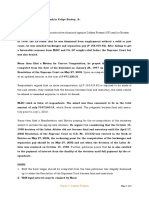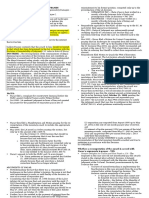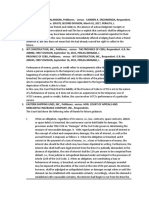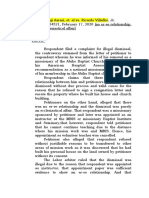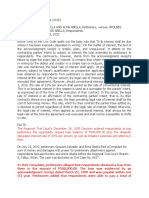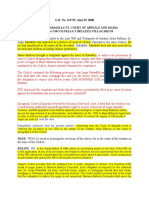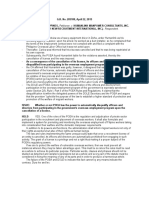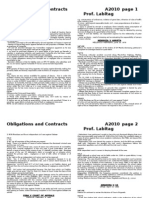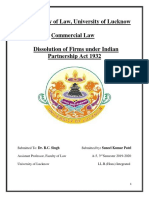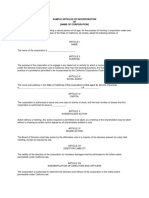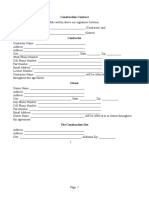9 Nacar Vs Frames
9 Nacar Vs Frames
Uploaded by
Naomi InotCopyright:
Available Formats
9 Nacar Vs Frames
9 Nacar Vs Frames
Uploaded by
Naomi InotOriginal Description:
Original Title
Copyright
Available Formats
Share this document
Did you find this document useful?
Is this content inappropriate?
Copyright:
Available Formats
9 Nacar Vs Frames
9 Nacar Vs Frames
Uploaded by
Naomi InotCopyright:
Available Formats
Dario Nacar vs.
Gallery Frames
Facts:
On October 15, 1998, the Labor Arbiter rendered a Decision in favor of petitioner and
found that he was dismissed from employment without a valid or just cause. Thus,
petitioner was awarded backwages and separation pay in lieu of reinstatement in the
amount ofP158,919.92.
Respondents appealed to the NLRC, but it was dismissed for lack of merit. Accordingly,
the NLRC sustained the decision of the Labor Arbiter. Respondents filed a motion for
reconsideration, but it was denied. Dissatisfied, respondents filed a Petition for Review
on Certiorari before the CA but it was likewise denied. Respondents then sought relief
before the Supreme Court. Finding no reversible error on the part of the CA, this Court
denied the petition in the Resolution dated April 17, 2002.
An Entry of Judgment was later issued certifying that the resolution became final and
executory on May 27, 2002. The case was, thereafter, referred back to the Labor
Arbiter for execution. Petitioner filed a Motion for Correct Computation, praying that his
backwages be computed from the date of his dismissal on January 24, 1997 up to the
finality of the Resolution of the Supreme Court on May 27, 2002. Upon recomputation,
the Computation and Examination Unit of the NLRC arrived at an updated amount in
the sum ofP471,320.31.
Respondents filed a Motion to Quash Writ of Execution, arguing, among other things,
that since the Labor Arbiter awarded separation pay of P62,986.56 and limited
backwages of P95,933.36, no more recomputation is required to be made of the said
awards. They claimed that after the decision becomes final and executory, the same
cannot be altered or amended anymore. LA denied the motion but the decision was
reversed by the NLRC on appeal.
Petitioner appealed to the CA but was denied, stating that since petitioner no longer
appealed the October 15, 1998 Decision of the Labor Arbiter, which already became
final and executory, a belated correction thereof is no longer allowed. The CA stated
that there is nothing left to be done except to enforce the said judgment. Consequently,
it can no longer be modified in any respect, except to correct clerical errors or mistakes.
Thus, petitioner filed this petition for review on certiorari.
ISSUE: Whether or not a re-computation in the course of execution of the labor
arbiter's original computation of the awards made is legally proper.
HELD: Yes.
Labor Law- computation of backwages
A source of misunderstanding in implementing the final decision in this case proceeds
from the way the original labor arbiter framed his decision. The decision consists
essentially of two parts.
The first is that part of the decision that cannot now be disputed because it has been
confirmed with finality. This is the finding of the illegality of the dismissal and the
awards of separation pay in lieu of reinstatement, backwages, attorney's fees, and legal
interests. The second part is the computation of the awards made.
By the nature of an illegal dismissal case, the reliefs continue to add up until full
satisfaction, as expressed under Article 279 of the Labor Code. The recomputation of
the consequences of illegal dismissal upon execution of the decision does not constitute
an alteration or amendment of the final decision being implemented. The illegal
dismissal ruling stands; only the computation of monetary consequences of this
dismissal is affected, and this is not a violation of the principle of immutability of final
judgments. That the amount respondents shall now pay has greatly increased is a
consequence that it cannot avoid as it is the risk that it ran when it continued to seek
recourses against the Labor Arbiter's decision.
Furthermore, the interest due shall itself earn legal interest from the... time it is
judicially demanded. In the absence of stipulation, the rate of interest shall be 12% per
annum to be computed from default, i.e., from judicial or extrajudicial demand under
and subject to the provisions of Article 1169 of the Civil Code.
When the obligation is breached, and it consists in the payment of a sum of money,
i.e., a loan or forbearance of money, the interest due should be that which may have
been stipulated in writing. Furthermore, the interest due shall itself earn legal interest
from the time it... is judicially demanded. In the absence of stipulation, the rate of
interest shall be 6% per annum to be computed from default, i.e., from judicial or
extrajudicial demand under and subject to the provisions of Article 1169 of the Civil
Code.
When an obligation, not constituting a loan or forbearance of money, is breached, an
interest on the amount of damages awarded may be imposed at the discretion of the
court at the rate of 6% per annum. No interest, however, shall be adjudged on
unliquidated claims or... damages, except when or until the demand can be established
with reasonable certainty. Accordingly, where the demand is established with
reasonable certainty, the interest shall begin to run from the time the claim is made
judicially or extrajudicially (Art. 1169, Civil Code),... but when such certainty cannot be
so reasonably established at the time the demand is made, the interest shall begin to
run only from the date the judgment of the court is made (at which time the
quantification of damages may be deemed to have been reasonably ascertained). The...
actual base for the computation of legal interest shall, in any case, be on the amount
finally adjudged.
When the judgment of the court awarding a sum of money becomes final and
executory, the rate of legal interest, whether the case falls under paragraph 1 or
paragraph 2, above, shall be 6% per annum from such finality until its satisfaction, this
interim period being deemed... to be by then an equivalent to a forbearance of credit.
You might also like
- G.R. No. 189871: August 13, 2013 Dario Nacar, Petitioner, V. Gallery Frames And/Or Felipe BORDEY, JR., Respondents. Peralta, J.Document5 pagesG.R. No. 189871: August 13, 2013 Dario Nacar, Petitioner, V. Gallery Frames And/Or Felipe BORDEY, JR., Respondents. Peralta, J.Cza PeñaNo ratings yet
- Nacar v. Gallery FramesDocument4 pagesNacar v. Gallery FramesKaren Ryl Lozada BritoNo ratings yet
- 10 NACAR Vs GALLERY FRAMESDocument4 pages10 NACAR Vs GALLERY FRAMESYPENo ratings yet
- Nacar v. Gallery Frames And:or Felipe Bordey, Jr.Document3 pagesNacar v. Gallery Frames And:or Felipe Bordey, Jr.Yvonne MallariNo ratings yet
- Transpo UploadDocument3 pagesTranspo UploadJuan Carlo CastanedaNo ratings yet
- Nacar Vs Gallery FramesDocument2 pagesNacar Vs Gallery FramesAngelo Navarro100% (1)
- Nacar Vs Gallery Frames Inc, G.R. No. 189871, August 13, 2013Document4 pagesNacar Vs Gallery Frames Inc, G.R. No. 189871, August 13, 2013Rizchelle Sampang-ManaogNo ratings yet
- Dario Nacar V. Gallery Frames: P471 320. Case Was Again Forwarded To The Computation andDocument3 pagesDario Nacar V. Gallery Frames: P471 320. Case Was Again Forwarded To The Computation andalexis_beaNo ratings yet
- Na Carv Gallery FramesDocument3 pagesNa Carv Gallery FramesAlykNo ratings yet
- Nacar v. Gallery FramesDocument2 pagesNacar v. Gallery FramesJave Mike AtonNo ratings yet
- No. 44 DARIO NACAR vs. GALLERY FRAMES (SABUERO)Document2 pagesNo. 44 DARIO NACAR vs. GALLERY FRAMES (SABUERO)juhrizNo ratings yet
- 20.) Nacar v. Gallery FramesDocument2 pages20.) Nacar v. Gallery FramesresjudicataNo ratings yet
- Credit TransactionsDocument7 pagesCredit TransactionstinctNo ratings yet
- Credit 2nd Meeting Copy LangDocument7 pagesCredit 2nd Meeting Copy LangJuan Carlo CastanedaNo ratings yet
- Full Title: Dario Nacar Vs - Gallery Frames And/Or Felipe Bordey, JR., STATEMENT OF FACTS Petitioner Dario Nacar Filed A Complaint BeforeDocument3 pagesFull Title: Dario Nacar Vs - Gallery Frames And/Or Felipe Bordey, JR., STATEMENT OF FACTS Petitioner Dario Nacar Filed A Complaint BeforeJuan Carlo CastanedaNo ratings yet
- Nacar Vs Gallery FramesDocument2 pagesNacar Vs Gallery Framesroselleyap20No ratings yet
- NACAR CASE 703 SCRA 439 - Civil Law - Torts and Damages - ActDocument2 pagesNACAR CASE 703 SCRA 439 - Civil Law - Torts and Damages - ActBoy Omar Garangan DatudaculaNo ratings yet
- Daro Nacar Vs Gallery Frames DigestDocument4 pagesDaro Nacar Vs Gallery Frames DigestMyra MyraNo ratings yet
- Case Digest First MeetingDocument5 pagesCase Digest First MeetingTungoranNo ratings yet
- Nacar Vs Gallery FramesDocument2 pagesNacar Vs Gallery FramesErish Jay ManalangNo ratings yet
- Nacar vs. Gallery FramesDocument2 pagesNacar vs. Gallery FramesMona Liza100% (1)
- Credit - NACAR Vs Gallery FramesDocument3 pagesCredit - NACAR Vs Gallery FramesKT100% (1)
- Session Delights Vs CA Case DigestDocument1 pageSession Delights Vs CA Case DigestJose Venturina VillacortaNo ratings yet
- Dario Nacar Vs Gallery FramesDocument2 pagesDario Nacar Vs Gallery FramesJerald ParasNo ratings yet
- CRedit Trans - Digests HWDocument2 pagesCRedit Trans - Digests HWYu BabylanNo ratings yet
- Moreno Dumapis, Francisco Liagao and Elmo Tundagui v. Lepanto Consolidated Mining CompanyDocument2 pagesMoreno Dumapis, Francisco Liagao and Elmo Tundagui v. Lepanto Consolidated Mining CompanyMae BrionesNo ratings yet
- Dario Nacar vs. Gallery Frames G.R. No. 189871, August 13, 2013Document16 pagesDario Nacar vs. Gallery Frames G.R. No. 189871, August 13, 2013Pricelda Villa-BorreNo ratings yet
- 163 Nacar V Gallery Frames (Ipan - Jhon Edgar)Document2 pages163 Nacar V Gallery Frames (Ipan - Jhon Edgar)Jhon Edgar IpanNo ratings yet
- Nacar Vs Gallery Frames GR No. 189871Document9 pagesNacar Vs Gallery Frames GR No. 189871Breth1979No ratings yet
- Nacar vs. Gallery Frames DigestDocument2 pagesNacar vs. Gallery Frames DigestYong NazNo ratings yet
- Dario Vs Gallery FramesDocument2 pagesDario Vs Gallery FramesKhenlie VillaceranNo ratings yet
- Case #7 - Nacar V Gallery Frames Et Al 703 SCRA 439Document6 pagesCase #7 - Nacar V Gallery Frames Et Al 703 SCRA 439Michelle CatadmanNo ratings yet
- Nacar Vs Gallery FramesDocument12 pagesNacar Vs Gallery Framesmuskeeters.rickyNo ratings yet
- Nacar vs. Gallery Frames, G.R. No. 189871, 13 August 2013Document2 pagesNacar vs. Gallery Frames, G.R. No. 189871, 13 August 2013ESS PORT OF LEGAZPI CPD-ESSNo ratings yet
- 19 - Molina vs. Pacific Plans, Inc. (655 SCRA 356 (2011) )Document5 pages19 - Molina vs. Pacific Plans, Inc. (655 SCRA 356 (2011) )Michelle CatadmanNo ratings yet
- Dario Nacar Vs Gallery Frames DigestDocument2 pagesDario Nacar Vs Gallery Frames DigestJay Jasper Lee100% (9)
- Lim v. HMR Philippines DigestDocument5 pagesLim v. HMR Philippines DigestMykee NavalNo ratings yet
- Doctrines CasesDocument16 pagesDoctrines CasesIndira PrabhakerNo ratings yet
- 151 Session Delights Ice Cream v. CA PDFDocument17 pages151 Session Delights Ice Cream v. CA PDFEdryd RodriguezNo ratings yet
- G.R. No. 213617 April 18 2018 Breach ObligationDocument5 pagesG.R. No. 213617 April 18 2018 Breach Obligationyvettequebral163No ratings yet
- Nacar Vs Gallery of FramesDocument18 pagesNacar Vs Gallery of FramesChristine Karen BumanlagNo ratings yet
- Interpleader Case Under Rule 62Document4 pagesInterpleader Case Under Rule 62Jenny JspNo ratings yet
- Nacar v. Gallery Frames GR. 189871Document9 pagesNacar v. Gallery Frames GR. 189871alliah SolitaNo ratings yet
- Nacar v. Gallery Frames (G.R. No. 189871)Document18 pagesNacar v. Gallery Frames (G.R. No. 189871)aitoomuchtvNo ratings yet
- 2011 NLRC Rules of ProcedureDocument75 pages2011 NLRC Rules of ProcedureJ.N.No ratings yet
- Prudential Bank and Trust Company vs. ReyesDocument13 pagesPrudential Bank and Trust Company vs. ReyesGayle AbayaNo ratings yet
- Nacar v. Gallery FramesDocument3 pagesNacar v. Gallery FramesLesly Bries100% (1)
- Spouses Solangon V SalazarDocument5 pagesSpouses Solangon V SalazarAra Lorrea MarquezNo ratings yet
- UPSI V DieselDocument3 pagesUPSI V DieselKaren Ryl Lozada BritoNo ratings yet
- MotumDocument2 pagesMotumDock AceNo ratings yet
- Nature: Complaint For Constructive Dismissal Before The NLRC Against FactsDocument3 pagesNature: Complaint For Constructive Dismissal Before The NLRC Against FactsPax AlquizaNo ratings yet
- Nacar V Frames CDDocument2 pagesNacar V Frames CDsharoncerro81No ratings yet
- Baronda v. CADocument9 pagesBaronda v. CAMaria AndresNo ratings yet
- Andrew James McburnieDocument3 pagesAndrew James McburniewhatrichNo ratings yet
- Labstan Case DigestsDocument14 pagesLabstan Case DigestsLea AndreleiNo ratings yet
- Tabujara III vs. Judge Fatima Gonzales-AsdalaDocument8 pagesTabujara III vs. Judge Fatima Gonzales-AsdalapandambooNo ratings yet
- Lbor Reltions CsesDocument261 pagesLbor Reltions Cses8600431No ratings yet
- Dishonour of Cheques in India: A Guide along with Model Drafts of Notices and ComplaintFrom EverandDishonour of Cheques in India: A Guide along with Model Drafts of Notices and ComplaintRating: 4 out of 5 stars4/5 (1)
- California Supreme Court Petition: S173448 – Denied Without OpinionFrom EverandCalifornia Supreme Court Petition: S173448 – Denied Without OpinionRating: 4 out of 5 stars4/5 (1)
- Labor Contract Law of the People's Republic of China (2007)From EverandLabor Contract Law of the People's Republic of China (2007)No ratings yet
- Bishop Shinji AmariDocument4 pagesBishop Shinji AmariNaomi Inot100% (1)
- Genato Vs BayhonDocument2 pagesGenato Vs BayhonNaomi InotNo ratings yet
- Nicanor Nacar Vs Nistal, JapitanaDocument2 pagesNicanor Nacar Vs Nistal, JapitanaNaomi InotNo ratings yet
- Facts:: Cases On The General Provisions of Succession and WillsDocument8 pagesFacts:: Cases On The General Provisions of Succession and WillsNaomi InotNo ratings yet
- GR 122480 BpiDocument1 pageGR 122480 BpiNaomi InotNo ratings yet
- GR 76778 ChavezDocument2 pagesGR 76778 ChavezNaomi InotNo ratings yet
- 9 Sps AbellaDocument7 pages9 Sps AbellaNaomi InotNo ratings yet
- 3 Ricardo BonillaDocument1 page3 Ricardo BonillaNaomi InotNo ratings yet
- Rabadilla Vs CADocument2 pagesRabadilla Vs CANaomi InotNo ratings yet
- Supreme CourtDocument6 pagesSupreme CourtNaomi InotNo ratings yet
- FACTS: Petitioner Was Hired by Respondent As Chief Officer Under Contract For Nine Months. HeDocument3 pagesFACTS: Petitioner Was Hired by Respondent As Chief Officer Under Contract For Nine Months. HeNaomi InotNo ratings yet
- 3Document2 pages3Naomi InotNo ratings yet
- 12 PNB Vs Sps ManaloDocument2 pages12 PNB Vs Sps ManaloNaomi InotNo ratings yet
- 7 DigestDocument2 pages7 DigestNaomi Inot100% (1)
- 9 DigestDocument2 pages9 DigestNaomi InotNo ratings yet
- 11 Sps Silos Vs PNBDocument7 pages11 Sps Silos Vs PNBNaomi InotNo ratings yet
- 8 Rolando de La Paz Vs L&JDocument2 pages8 Rolando de La Paz Vs L&JNaomi InotNo ratings yet
- 11 DigestDocument1 page11 DigestNaomi InotNo ratings yet
- Jakerson G. Gargallo vs. DOHLE Seafront Crewing, Inc., Et Al. G.R. No. 215551 August 17, 2016Document2 pagesJakerson G. Gargallo vs. DOHLE Seafront Crewing, Inc., Et Al. G.R. No. 215551 August 17, 2016Naomi InotNo ratings yet
- 24 - DigestDocument3 pages24 - DigestNaomi InotNo ratings yet
- 5 DigestDocument2 pages5 DigestNaomi Inot100% (1)
- Labor CasesDocument21 pagesLabor CasesBillie Balbastre-RoxasNo ratings yet
- People Vs BalunsatDocument2 pagesPeople Vs BalunsatEzra Dan BelarminoNo ratings yet
- G.R. No. 237428, May 11, 2018Document14 pagesG.R. No. 237428, May 11, 2018ulticonNo ratings yet
- Roco vs. Contreras (G.R. No. 158275, June 28, 2005)Document8 pagesRoco vs. Contreras (G.R. No. 158275, June 28, 2005)AndresNo ratings yet
- TRF LTD Vs Energo Engineering Projects LTD 0307201SC20171807171045272COM952734Document20 pagesTRF LTD Vs Energo Engineering Projects LTD 0307201SC20171807171045272COM952734Aman BajajNo ratings yet
- Week 6 Case 5Document6 pagesWeek 6 Case 5Earl NuydaNo ratings yet
- United States Court of Appeals, Tenth CircuitDocument5 pagesUnited States Court of Appeals, Tenth CircuitScribd Government DocsNo ratings yet
- Tufexis V Olaguera DigestDocument3 pagesTufexis V Olaguera DigestNikki Estores GonzalesNo ratings yet
- Topic 1 - Promise To Marry (Betrothal)Document3 pagesTopic 1 - Promise To Marry (Betrothal)Amy SallynaNo ratings yet
- Torts OutlineDocument129 pagesTorts OutlineAmanda Fazio100% (1)
- Emorandum For Espondent: T A W C. V I C A MDocument55 pagesEmorandum For Espondent: T A W C. V I C A MDeepak KumarNo ratings yet
- Pagsibigan vs. PeopleDocument7 pagesPagsibigan vs. PeopleCJNo ratings yet
- Mnemonics From Atty. Manuel Riguerra'S Remedial Law Books (Sixth EDITION (2020) )Document18 pagesMnemonics From Atty. Manuel Riguerra'S Remedial Law Books (Sixth EDITION (2020) )Robert Paul A Moreno100% (1)
- A2010 Compiled Oblicon DigestsDocument196 pagesA2010 Compiled Oblicon Digestscmv mendoza100% (4)
- Faculty of Law, University of Lucknow Commercial Law Dissolution of Firms Under Indian Partnership Act 1932Document12 pagesFaculty of Law, University of Lucknow Commercial Law Dissolution of Firms Under Indian Partnership Act 1932Suneel Kumar PatelNo ratings yet
- Tulsa Police Report and Amended AnswerDocument16 pagesTulsa Police Report and Amended AnswerwatchkeepNo ratings yet
- Alejo Vs CortezDocument14 pagesAlejo Vs CortezAngel Pagaran AmarNo ratings yet
- Full Case - Deluao vs. CasteelDocument18 pagesFull Case - Deluao vs. CasteelanalynNo ratings yet
- ExamDocument10 pagesExamErvien A. MendozaNo ratings yet
- Statcon Notes AgpaloDocument28 pagesStatcon Notes Agpalodianne rebutarNo ratings yet
- Ap Shuhada Anor V Ah Design Comm (Sessions Appeal) - Appeal +@001Document8 pagesAp Shuhada Anor V Ah Design Comm (Sessions Appeal) - Appeal +@001MCSNo ratings yet
- Articles of Incorporation TemplateDocument2 pagesArticles of Incorporation Templateaeron.dingli100% (1)
- Transpo Reviewer 1-5Document5 pagesTranspo Reviewer 1-5Zaira Gem GonzalesNo ratings yet
- Civil Code of The PhilippinesDocument3 pagesCivil Code of The PhilippinesMarionne GNo ratings yet
- Mabalo v. Heirs of BabuyoDocument23 pagesMabalo v. Heirs of BabuyoJashen TangunanNo ratings yet
- Canet vs. Decena G.R. No. 155344 January 20, 2004Document18 pagesCanet vs. Decena G.R. No. 155344 January 20, 2004Krizia Marie Dancel GangoNo ratings yet
- GR 170865 PNB Vs Chee ChongDocument7 pagesGR 170865 PNB Vs Chee Chongmaria lourdes lopenaNo ratings yet
- Cagayan Valley Drug Corporation vs. Commissioner of Internal RevenueDocument3 pagesCagayan Valley Drug Corporation vs. Commissioner of Internal RevenueAmer Lucman IIINo ratings yet
- Dean Ralph Sarmiento's Bar Exam Notebooks - PhotosDocument1 pageDean Ralph Sarmiento's Bar Exam Notebooks - PhotosNoel AtienzaNo ratings yet
- ALHome Repair IDocument10 pagesALHome Repair Isharif uddinNo ratings yet



